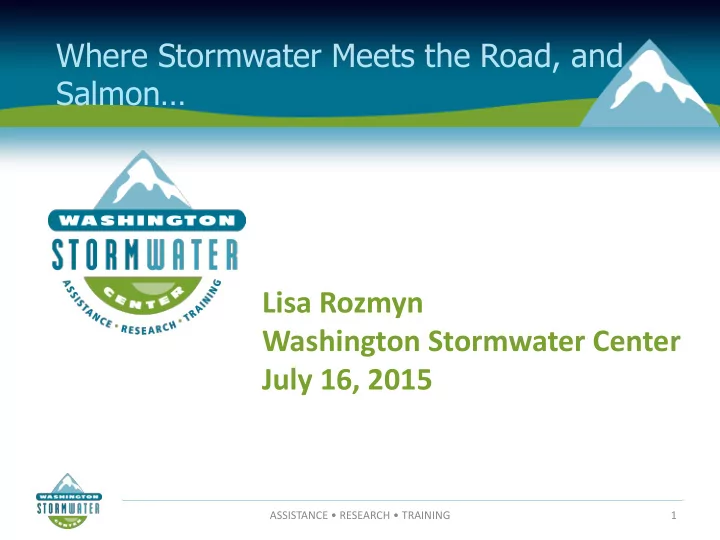

Where Stormwater Meets the Road, and Salmon… Lisa Rozmyn Washington Stormwater Center July 16, 2015 ASSISTANCE • RESEARCH • TRAINING 1
Stormwater Discussion Topics What is it? Why is it a problem? What are the effects of stormwater pollution? Where does all that pollution go? What are the effects of too much runoff? Traditional stormwater management Low Impact Development 2
What is Polluted Runoff? Water that originates during precipitation events Water from rain, snow, sleet, hail, that flows across the ground and pavement or when snow and ice melt. Clean Water Act says – we have to manage that water- both quality and quantity Who? Businesses, Municipalities – NPDES Permits You and me. 3
Brief History….. My first exposure to the Industrial Stormwater General Permit. 4
My initial thoughts: We’re going to regulate rain? Aren’t businesses burdened enough? Don’t businesses and municipalities have more important things to worry about than rainwater? How much is this going to cost them? Doesn’t EPA have better things to do??? It’s just rain, for goodness sake!!! 5
Then I was “Schooled” about Stormwater 6
Stormwater is a problem for two reasons: Quality - Pollutants Quantity – Erosion, Flooding 7
3 rd Reason: Economic Impacts Not paying attention to, or planning for stormwater impacts impairs the value of your investments in infrastructure, drinking water, and environmental quality of life (the #1 business attractor) BNSF Agrees to Pay $2.5 Million to Settle Alleged Stormwater Discharge Violations Clark County to pay $3.6 million for violating Clean Water Act 8
The Culprits! Impervious surfaces – dirt, oil, heavy metals Aerial deposition – wood stoves, car exhaust, dust Building materials – galvanized surfaces, treated lumber, moss killer Household products and practices – pesticides, fertilizers, pressure washing, car washing, leaking vehicles, pet waste It’s everywhere – We are all Potentially Responsible Parties. 9
Pollutants of Concern Metals Suspended Solids Nutrients pH Turbidity Oil and Grease 10
Zinc – Tires, galvanized surfaces, oil, moss removal 11
Copper – Brake pads, anti-fouling paints, exposed copper surfaces, biocides 12
Suspended Solids – windblown, tracked in, construction sites 13
Pollution Problems Human Health and Recreation 14
Pollution Problems Aquatic Life: Nutrients and fertilizers – algal blooms that suck up all the oxygen that fish need to breathe Impairs salmon ability to detect predators Benthic organisms impaired 15
Where does all that pollution go? Stormwater System vs Sanitary Sewer Messaging should include this fact: Most Stormwater flows untreated into the nearest water body Even if your storm drain is miles from Puget Sound, the Columbia River, the Ocean, Spokane River, etc – if it goes into a pipe, it usually discharges into a waterbody. Puget Sound Starts Here WSC Video: Storm Trek Sightline Institute: http://daily.sightline.org/files/downloads/2012/05/stormwat er-messaging.pdf 16
What does the data say? Phase I MS4s required to monitor, data submitted to Ecology, what’s the result? http://www.ecy.wa.gov/programs/wq/stormwater/munici pal/s8dswmonitoring.html 17
Source Tracing and Control Easier to prevent pollution in stormwater than to remove it after. Know the sources, be able to identify them Example: Chain link fence = zinc Sneaky invisible pollutants: WSC Source Tracing Video BMPs for prevention, and if needed, Treatment Approved treatment BMP’s for Municipalities: TAPE Protocol for testing and approval. 18
Water Quantity – Too much, too fast Damage to streams – erosion, streamside vegetation damage, loss of shade needed for habitat Loss of habitat – dirt from erosion smothering aquatic life 19
Quantity – Erosion & Sediment Control From minor soil erosion: To major damage: Sumner construction company owner pleads guilty to pollution crimes 20
Quantity continued Flooding (urban) Lack of capacity in the system – too much impervious area, pipes not big enough, etc Lack of maintenance – rake a drain, clean a basin, jet the pipes Too much rain + lack of maintenance + lack of capacity + storm serge/high tide = 21
Urban flooding 22
Traditional way of managing stormwater – Just Get it Outta Here!!! 23
Pompeii – 79 AD ASSISTANCE • RESEARCH • TRAINING
Traditional Stormwater Containment and Treatment 25
Water is a Valuable Resource! 26
Low Impact Development - Trying to make this: 27
Behave like this: 28
LID Concepts: Mimic Natural Hydrology Infiltrate (soak in) Filter (strain and clean) Detain (stop and wait) Recharge Groundwater (fill up) Evaporate (dry off, not runoff) Control & Treat Runoff Near the Source Don’t Concentrate Flows (prevent flooding) Use Plants to Remove Contaminants ASSISTANCE • RESEARCH • TRAINING
LID Examples Bioretention/Bioswales Infiltration Permeable pavements Green Roofs Rain Gardens 30
Bioretention/Rain Gardens 31
Porous Asphalt/Permeable Concrete 32
Contact the WSC Washington Stormwater Center Offering stormwater management assistance to Washington NPDES permittees and stormwater managers by providing access to information, training, permit assistance, research and emerging technologies. www.wastormwatercenter.org 1-855-WASTORM Lisa.Rozmyn@wsu.edu (253)445-4552 ASSISTANCE • RESEARCH • TRAINING
Recommend
More recommend